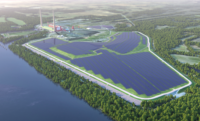
Construction is expected to start this summer on Minnesota's largest solar-energy project, 100 MW total in distributed photovoltaic arrays sited near utility substations. The state's Public Utilities Commission approved the $250-million project's site permit last month and the developer says the operator is seeking bids for construction.
Minnesota PUC approved 21 sites for the Aurora Distributed Solar Energy project on May 28, concluding a process that included an upset victory for the developer. Early in the approval process, Geronimo Energy bested three gas-turbine competitors to earn an administrative law judge's recommendation based on the solar project's superior life-cycle value.
 |
| ENGELKING |
Responding to an Xcel Energy solicitation, Geronimo proposed a total of 130 MW on 24 sites, and PUC approved 118 MW on 21. "It's always been intended to be 100 MW, but we went in for our permit with more sites than we really needed, because when you start building and doing some of your other work, you may come up with constructibility issues," Engelking says.
For example, geotech boring revealed that bedrock underlay much of one site, "which is going to be a problem for installing poles." That is the only site where she anticipates challenges. "We don't intend to pour concrete to install the project; we simply intend to vibrate the poles down into the ground." If that proves infeasible, the site will be abandoned and construction will be moved to another permitted site, she says.
"A couple of the (unpermitted) sites we felt were pretty important to the project, but that doesn't mean we can't build the project without them," she adds. "There may be some minor increase to cost, but it shouldn't affect the success of the project at all."
Geronimo is planning construction start by fall, with the goal of completing construction by September 2016. "We need to have everything online by the end of 2016," Engelking says. The operator, Enel Green Power North America Inc., is soliciting bids for construction, but she doesn't know whether any have been received. "We expect to select one, probably around August," she says. Enel did not return calls asking for comment.
Solar energy costs have been collapsing, and Aurora's $250-million cost testifies to the trend, penciling out to $2.5 million per installed megawatt, comparable to the cost of a coal-fired powerplant, "in some cases cheaper," Engelking adds. Besides the generation capacity it provides, the project also provides "environmental benefits that help the utility move toward statewide goals and requirements," Engelking says. Xcel is required to provide 31.5% of total retail electricity sales from renewable sources by 2020, of which 1.5% must be solar.
"The Geronimo project is one of four large-scale solar projects that have purchase power agreements with Xcel Energy," says Patti Nystuen, Xcel spokeswoman. The others are the 100-MW North Star Solar project, the 62-MW Marshall Solar project and the 25-MW Minnesota Solar I project. All are to be online by the end of 2016.




